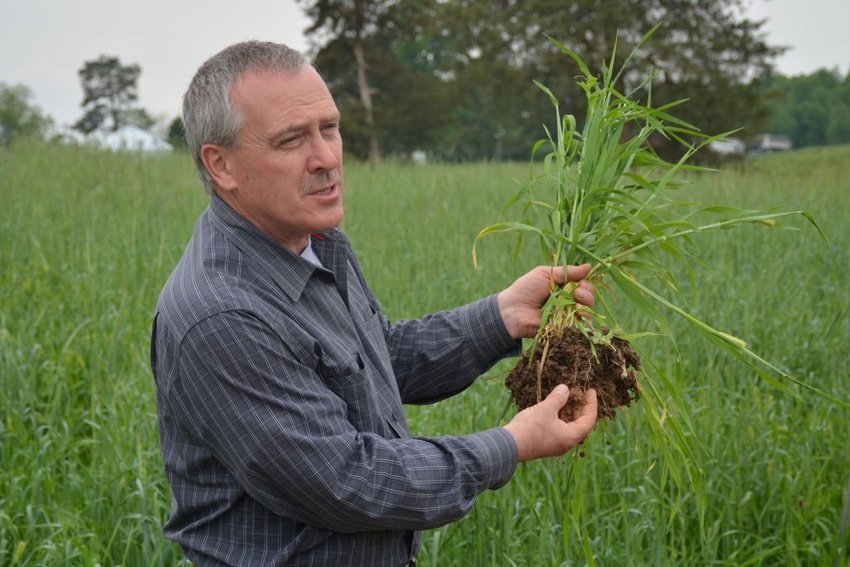
Carbon is a currency of exchange; it is the food in the soil profile for the biology.Through the carbon cycle, carbon dioxide comes into the plant through the stomata while oxygen and water vapor leave the plant through the stomata. Once the carbon enters the plant, the plant uses part of the carbon to build itself.

When considering a cover crop, farmers need to understand the carbon cycle.
Speaking at a soil health field day at Fork L Farm in Norwood, N.C. April 29, Jay Fuhrer, a nationally known expert on soil health, said when farmers think about carbon they should think about food. “Carbon equals food,” he said. “Carbon is a currency of exchange; it is the food in the soil profile for the biology.”
Fuhrer is a conservationist employed by the Natural Resources Conservation Service in Bismarck, N.D. He grew up on a small grain and livestock farm in North Dakota. He also spoke at two other soil health field days in North Carolina in the last week in April.
Through the carbon cycle, carbon dioxide comes into the plant through the stomata while oxygen and water vapor leave the plant through the stomata. Once the carbon enters the plant, the plant uses part of the carbon to build itself, Fuhrer explained.
“When you take a green plant, it’s probably going to be over 40 percent carbon,” Fuhrer pointed out. “It has to build itself, the structure of the plant. It’s going to go ahead and give off carbon or sugars. It gives it off as exudates which are food for the the biology. As the plant gives off these exudates, biology comes over and consumes it. When the biology eats all of that, the lights come on in the factory in the soil profile and the conveyor belt starts to run.”
As the plant takes on carbon, soil aggregates or small particles of soil are built.
“These soil aggregates are fused together by glues and the glues are made by a combination of a fungi and the plant together so the plant and the fungi make the glues, the soil biology as a whole starts to put these soil aggregates together,” Fuhrer said.
For the plant to get water when it rains, pore spaces serve as doorways which allow water to enter the plant. “There’s a little bit of a pore space between every soil aggregate,” Fuhrer said.
“If we have some residue on the surface, if we have diversity in our cropping system, if we’ve taken erosion out of the equation and if we have a no-till system, the biology is going to take some of this carbon and move it in to the soil organic matter. Then we start to see a little increase in soil organic matter,” he added.
Just as humans need a diversity of food to be healthy, soil needs a diversity of cover crops to remain healthy, Fuhrer said. Farmers need to give each field what it needs in terms of diversity.
“Diversity of plant residues equates to diversity of the soil food web; there is a direct correlation,” Fuhrer said. “If you feed a monoculture, one crop type, continually on the field, your biology is going to suppress down. It would be like us eating one particular food day after day after day. It would be like eating broccoli three meals a day. For me, that doesn’t work; I’m a meat and potatoes guy so consequently if we have a plethora of a diversity of food, the biology will be stronger just as a diversity of food makes us stronger.”
Fuhrer said cover crops are ideal for “catching and releasing” nutrients in the soil. Soil aggregates create pore spaces that allowing farmers to feed carbon into the biology. Plant residue is critical, he advised.
“You can have a no-till field and be the best no tiller in the county, but if you don’t have residue on the soil surface, you’re not going to prevent compaction even though you are a no tiller. Rain packs, we know this, so if you look at it from a compaction viewpoint, we either need to have a green plant or we need to have dead residues. If we have both, that’s great too.”
Healthy soils need to have something to take the energy out of the rainfall. “We have some great no-tillers, but if they have no cover on the field, it’s not so good,” Fuhrer said.
About the Author(s)
You May Also Like





